26 Conjunctivodacryocystorhinostomy

Conjunctivodacryocystorhinostomy (CDCR) is a lacrimal bypass procedure designed to circumvent stenosis or obstruction of the canalicular system by establishing a drainage conduit between the lacrimal lake and the nasal cavity. Common causes of canalicular obstruction include unsuccessful repair of a lacerated canaliculus, damage to the canaliculi from repeated probings, viral or chlamydia infections of the conjunctiva and lacrimal sac, chronic use of miotics or antiherpetic drugs, partial or total loss of the canalicular system secondary to tumor removal, congenital malformation of the lacrimal drainage system, inflammatory conditions such as sarcoidosis, iatrogenic thermal punctal closure, or idiopathic. Dacryocystorhinostomy (DCR) with Jones tube placement may also be indicated for failed DCR revisions in which the canaliculi are patent but nonfunctional.
PREOPERATIVE EVALUATION
Preoperative examination of the nasal cavity is imperative to rule out a deviated septum, enlarged middle turbinate, or any nasal abnormalities. A severely deviated nasal septum toward the operative side will invariably compromise proper placement and function of the Jones tube; hence, correction of this problem before CDCR surgery may be advisable. Preoperative recognition of an enlarged middle turbinate will alert the surgeon of a possible intraoperative need for partial turbinectomy to improve visualization and positioning of the tube.
Patients should be advised that the glass tubes will remain with them for the rest of their lives and that direct trauma to the medial canthal region can cause breakage.
SURGICAL TECHNIQUE
A standard DCR is performed, as described in the previous chapter, up to the step of uniting the posterior flaps of the nasal mucosa and lacrimal sac. After anastomosis of the posterior flaps, the position of the middle turbinate is inspected. If the anteroinferior tip is situated above the plane of the posterior flaps and will likely affect the orientation of the Jones tube, it is then resected with a front-biting Takahashi forceps or angled scissors. Brisk bleeding will be encountered but can be minimized by injecting lidocaine with epinephrine 15 to 20 minutes before resection. The use of a sheet of Surgicel (or Gelfoam soaked in thrombin) over the cut surface and packing with cocaine-moistened cottonoid will greatly enhance hemostasis.
The caruncle is infiltrated with a small amount of 2% lidocaine with 1:100,000 dilution of epinephrine on a 30-gauge needle. The needle then penetrates the conjunctiva medial to the caruncle and aimed toward the internal ostium in a 30° to 40° inferonasal direction. As the needle is advanced forward, anesthetic is infiltrated along this path.

Figure 26-1. Instead of excising the caruncle, as is frequently recommended, a horizontal snip incision is made on the caruncle with a Westcott scissors. Preservation of the caruncle permits it to serve as a collar for a snug fit of the canthal flange and prevents nasal migration of the tube.
Stay updated, free articles. Join our Telegram channel

Full access? Get Clinical Tree


